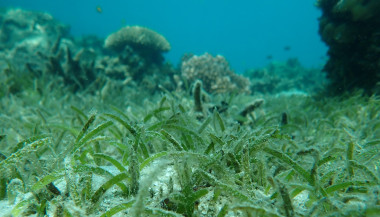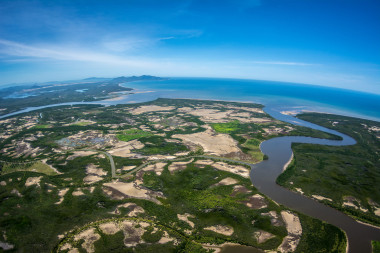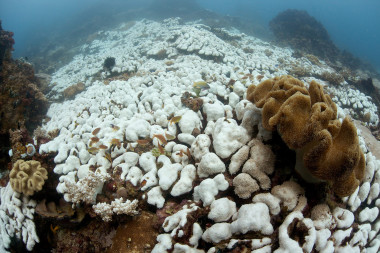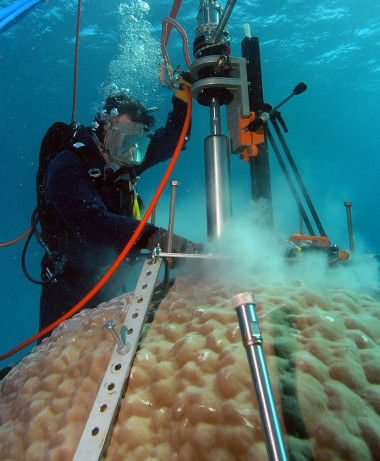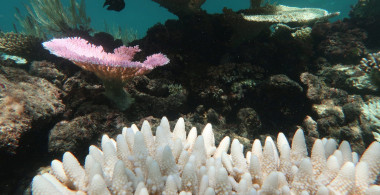The Great Barrier Reef was listed as an UNESCO World Heritage Area in 1981 due to its Outstanding Universal Value and is one of the most complex natural systems on Earth. It spans 348,000 km2 and encompasses multiple ecosystems across terrestrial and aquatic landscapes and is highly valued at local, national and international scales. However, the Great Barrier Reef is subject to a growing number of local and global pressures which can affect the health of Great Barrier Reef ecosystems, resulting in serious concerns for its long-term outlook.
Scope
The diagram below shows the scope of this theme. It represents a section of the Great Barrier Reef catchment and marine environment, including the main ecosystems covered in the 2022 Scientific Consensus Statement (inshore and offshore coral reefs, seagrass meadows, mangroves, estuaries, saltmarshes, freshwater wetlands, plankton and microbes, fish, megafauna, and other pelagic and benthic communities) and the ecosystem connections, the main values (ecological, cultural, economic and social) and the main drivers of health such as climate change, poor water quality – including increased sediments, nutrients, pesticides and other pollutants, coastal development, invasive species, outbreaks of crown-of-thorns starfish, and other pressures related to direct use.
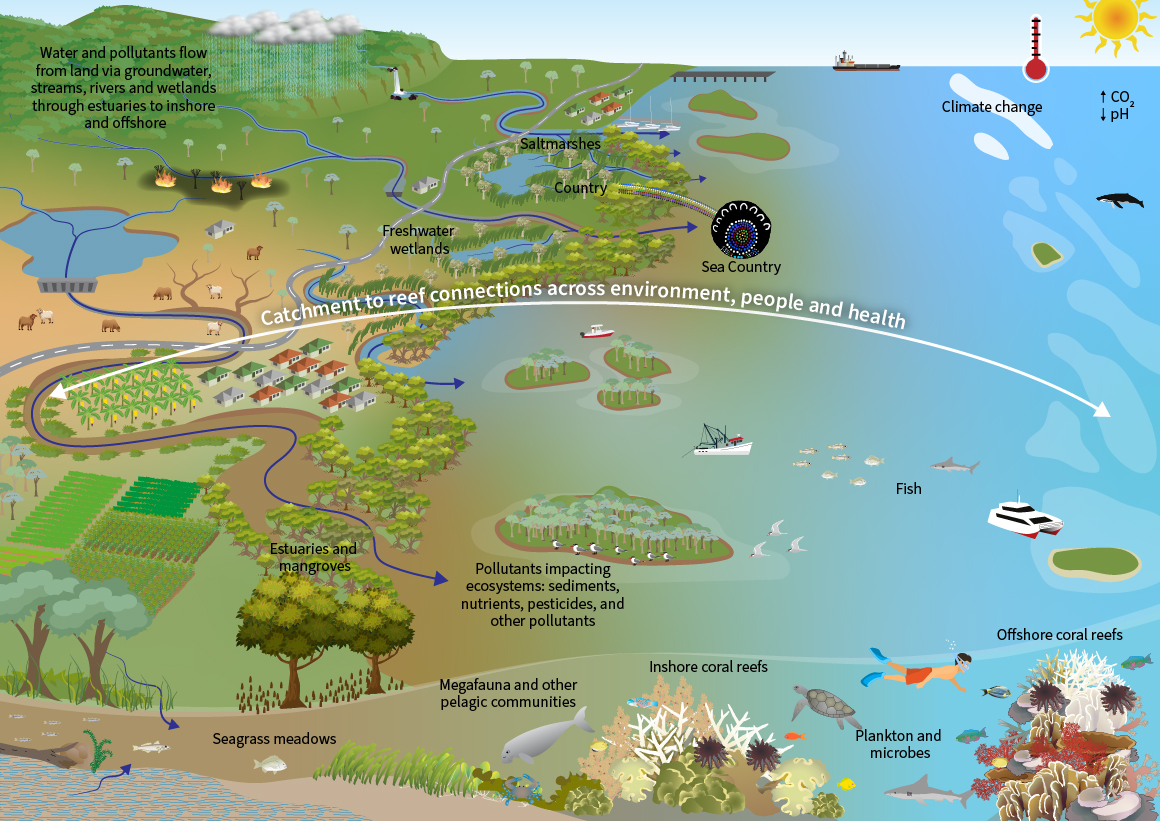
Context
The Great Barrier Reef is one of the most complex natural systems on Earth and was listed as a UNESCO World Heritage Area in 1981 due to its Outstanding Universal Value. It spans 348,700 km2 and encompasses multiple ecosystems across terrestrial and aquatic landscapes and is highly valued at local, national and international scales. However, the Great Barrier Reef is subject to a growing number of local and global pressures which can affect the health of its ecosystems, resulting in serious concerns for the long-term outlook of the Great Barrier Reef.
The synthesis of the evidence for the values, condition and drivers of health of the Great Barrier Reef included a total of 1,023 studies extracted and synthesised for 6 questions (with some overlap in evidence between questions). The questions in this theme provide the relevant background information for the 2022 Scientific Consensus Statement including evidence of the ecological, cultural, and socioeconomic assets and values for the Great Barrier Reef (Q1.1), and the current status, condition and key threats for selected ecosystems (Q1.2/1.3/2.1). Evidence about the impact of climate change, the primary threat to the health of the Great Barrier Reef (Q2.2), and the interaction between climate change and poor water quality (Q2.4) are examined in more detail. Connectivity between the Great Barrier Reef catchment, coastal and marine ecosystems, and the threats to those connections, are also described (Q1.4), as is evidence for changes in land-based runoff to the Great Barrier Reef since the arrival of Europeans (Q2.3).
Summary statement for Values, condition and drivers of health of the Great Barrier Reef
The synthesis of the evidence included a total of 1,023 studies extracted and synthesised for 6 questions (with some overlap in evidence between questions). The Summary Statement was developed using the evidence base from the six questions in this theme. Convergence was reached for this Summary Statement among all authors within the Expert Group for this theme.
The summary of findings relevant to policy or management action for the values, condition and drivers of health of the Great Barrier Reef are:
- The Great Barrier Reef covers an area of 348,700 km2 from the tip of Cape York to Bundaberg (including 24,094 km2 of coral reefs, 35,679 km2 of seagrass meadows, 2,188 km2 of mangroves, 1,757 km2 of salt flats and saltmarshes, and 15,556 km2 of wetlands). It has high connectivity to the adjacent catchment area (424,000 km2), as demonstrated by input of land-based materials (especially sediments, organic material, nutrients and pesticides), movements in the life histories of many species and the dispersal of plankton and movement of larger organisms. Connections across the catchment to reef landscape are diverse and essential to many biogeochemical and ecological processes, plants and animals, and may be modified or interrupted by some natural and, increasingly, anthropogenic processes and drivers such as floodplain drainage, artificial structures for water management, stretches of poor water quality, and dense plant growth. [Q1.2/1.3/2.1, Q1.4]
- The Great Barrier Reef encompasses ecological, social, economic, and culturally diverse (including Indigenous heritage) values which are also interconnected. Any decline in the condition of ecosystems, including disruption of ecological processes, can also have a direct impact on connected socio-ecological services and other Great Barrier Reef values. [Q1.1, Q1.4]
- The current condition of the Great Barrier Reef varies between ecosystems and locations. Observational studies report that the condition of Great Barrier Reef inshore coral reef ecosystems from the Wet Tropics to the Fitzroy region has declined marginally since 2017 and was categorised as ‘Poor’ condition in 2020 to 2021[1] (based on a multi-indicator resilience index) with regional differences. Hard coral cover on shallow mid- and outer shelf reefs has increased overall since 2017, showing fast recovery from Cooktown to Bundaberg after experiencing losses from repeated mass coral bleaching and/or crown-of-thorns starfish between 2016 and 2019[2]. Inshore seagrass meadows across the Great Barrier Reef declined from ‘Moderate’ abundance and resilience in 2017 to ‘Poor’ in 2020[1], and while overall condition improved in 2021 (to Moderate), there were continuing declines in the Fitzroy and Burnett Mary regions. These declines were primarily a consequence of above-average discharges from some rivers and disturbance from tropical cyclones. Mangroves and saltmarsh ecosystems are considered stable and in Good condition[3], and wetlands are considered stable but in Moderate condition[1], however, historical loss of wetland extent has been significant for some wetland types in some regions. [Q1.2/1.3/2.1]
- Although the overall primary threat to Great Barrier Reef ecosystems is climate change, poor water quality from land-based delivery of fine sediments, nutrients, pesticides and other pollutants is also a major threat, especially for freshwater, coastal and inshore marine ecosystems. Other threats including tropical cyclones and storms, crown-of-thorns starfish and, to a lesser extent, direct use, can impact certain ecosystems at different levels. Multiple stressors acting in a cumulative manner are also becoming increasingly important. [Q1.2/1.3/2.1]
- Studies over the last three decades confirm that the climate of the Great Barrier Reef is changing rapidly and in multiple ways, with some changes already significantly impacting Great Barrier Reef ecosystems, organisms and water quality. These impacts are occurring through rising temperature, increasing frequencies of marine heatwaves, increasing ocean acidification, sea level rise, and more extreme rainfall events. Additional regionally specific predictions include increasing frequency of droughts and drought-breaking floods in the southern Great Barrier Reef (south of Bowen), and a potential reduction in the frequency but increasing intensity of tropical cyclones in the northern Great Barrier Reef (north of Bowen). [Q2.2]
- There is consistent evidence that periods of extreme sea surface temperature are causing mass coral bleaching and mortality. Thermal extremes also cause stress and damage to numerous other marine organisms including some species of fish, sponges, and seagrasses. There is limited information on the impacts of climate change on Great Barrier Reef wetlands. [Q2.2]
- There are multiple lines of evidence demonstrating that the volume of river discharge and loads of suspended sediment, dissolved and particulate nutrients (nitrogen and phosphorus), and pesticides have increased for most river basins of the Great Barrier Reef catchment area since the arrival of Europeans c. 1850. The increases in loads have largely occurred because catchments have been modified for the major land uses of livestock grazing (73% of catchment area), irrigated and dryland cropping (2.8%), sugarcane (1.2%), horticulture and bananas (0.2%), urban development (0.7%) and mining (0.3%), in combination with long-term climate variability. Evidence of increases in catchment loads comes from fluvial proxy records, coral-reef proxies (including coral and reef sediment cores), water quality monitoring and subcatchment and catchment-scale modelling. [Q2.3]
- The footprint of increased land-based runoff and pollutant loads within the Great Barrier Reef is most pronounced in estuarine, coastal and inshore environments but can be evident more than 100 kilometres alongshore from the river mouth of influence. Those ecosystems nearest to the mainland are at greatest risk from exposure to chronic poor water quality associated with land-based runoff. While these areas generally represent a relatively small proportion of the Great Barrier Reef, they provide critical ecosystem services and maintain high tourism, aesthetic, spiritual and recreational values. [Q1.1, Q1.2/1.3/2.1, Q2.3]
- There is consistent evidence that climate change factors (including temperature and ocean acidification) and water quality characteristics (including nutrients, light/sediments and pesticides) have interactive effects on a variety of organisms in coral reef ecosystems of the Great Barrier Reef. In the majority of cases, the outcome for the organism is worse under these combined stressors. Improved water quality indirectly benefits coral reef ecosystems by increasing resilience of organisms and reducing recovery time following acute disturbances such as bleaching, crown-of-thorns starfish outbreaks and cyclones. Resilience will become increasingly important as climate pressures continue to grow. [Q2.4]
- The evidence confirms the urgency of meeting all Great Barrier Reef water quality targets within the next ten years before impacts exceed the capacity for Great Barrier Reef ecosystems to persist. [Q2.2]
- Current knowledge of the catchment to reef landscape is sufficient to provide a holistic framework for future policy and management, incorporating cross-disciplinary and cross-jurisdictional planning to the entire catchment to reef landscape. [Q1.4]
[1] Reef Water Quality Report Card 2020
[2] AIMS Long Term Monitoring Program
[3] Great Barrier Reef Outlook Report 2019
Confidence
The confidence rating of the questions in this theme was High with only Question 2.3 rating Moderate-High due to Moderate-High consistency in the results.
Strength of evidence
The findings are underpinned by a large body of evidence, including concepts that have been consistently repeated for more than three decades. The strength of evidence across this theme, considering the confidence, quantity and diversity of study types is generally considered to be consistently High, with some exceptions related to the cumulative effects of different pressures, and the impacts of pressures on coastal ecosystems including estuaries, mangroves and freshwater wetlands.
Key uncertainties
The key uncertainties identified in this theme were associated with the extrapolation of the key findings under different episodic climatic events or under changing climate conditions. Additionally, not all Great Barrier Reef ecosystems and habitats are equally assessed spatially or temporally, rendering overall condition assessments, and prediction of future responses to increasing threats, challenging.
Recent findings
Recent findings show the need for greater emphasis on social values, on the role of Indigenous Knowledge in decision making for the Great Barrier Reef, further documentation of evidence of land use change in the catchment area, and a shift in the severity of climate-related impacts on Great Barrier Reef ecosystems and associated values. Climate-related impacts are predicted to intensify rapidly throughout this century, with severity depending on global carbon dioxide emission pathways. The importance of the role of improved water quality in the context of climate change has become clearer and the evidence of the combined effects of climate and different water quality conditions has strengthened.
Knowledge gaps
For the values, condition and drivers of health of the Great Barrier Reef, the areas where further knowledge is needed that are most relevant to policy and management are:
- Greater understanding of the interconnectivity between the socio-ecological, cultural, intrinsic and economic values of the Great Barrier Reef.
- Greater spatial and temporal assessment for wetlands and deep marine ecosystems within the Great Barrier Reef.
- Further development of new rare earth element and longer-term coral proxies to help reconstruct changes in sediment and particularly nutrient exposure in the Great Barrier Reef.
- Increased knowledge of the combined impact of multiple stressors on a range of ecosystems and species.
- Identifying whether water quality guidelines need to be adjusted under changing climatic conditions.
Summary information for Values, condition and drivers of health of the Great Barrier Reef
The table below summarises the evidence appraisal indicators and confidence ratings in the evidence base for each of the Questions in this theme. The Confidence rating was determined by the overall relevance of studies to the question and the consistency of the body of evidence (see the Glossary for an explanation of the indicators). Note: In Diversity of items: Experimental (E), Mixed (X), Modelling (M), Monitoring (N), Observational (O), Reviews (R), Theoretical or Conceptual (T), Proxy (P), Sediment Cores (C).
| Question | Quantity of items | Diversity of items | Overall Relevance | Consistency | Confidence |
| What are the socio-ecological, cultural, economic and intrinsic values of the Great Barrier Reef? [Q1.1] | High (85) |
High (62% O, 19% R, 11% M, 5% E, 3% T) |
High | High | High |
| What is the extent and condition of Great Barrier Reef ecosystems and what are the primary threats to their health? [Q1.2/1.3/2.1] | High (100) |
High (52% O, 27% M, 19% R, 2% T) |
High | High | High |
| How are the Great Barrier Reef’s key ecosystem processes connected from the catchment to the reef and what are the primary factors that influence these connections? [Q1.4] | High (276) |
Moderate (69% O, 15% R, 14% M, 2% E) |
High | High | High |
| What are the current and predicted impacts of climate change on Great Barrier Reef ecosystems (including spatial and temporal distribution of impacts)? [Q2.2] | High (317) |
High (37% O, 32% E, 22% M, 9% R) |
High | High | High |
| What evidence is there for changes in land-based runoff from pre-development estimates in the Great Barrier Reef? [Q2.3] | High (128) |
High (64% E-O including 44% P & 20% C; 15% N, 12% O, 9% M) |
High | Moderate-High | Moderate-High |
| How do water quality and climate change interact to influence the health and resilience of Great Barrier Reef ecosystems? [Q2.4] | High (117) |
High (61% E, 13% M, 13% R, 9% X, 4% O) |
High | High | High |

